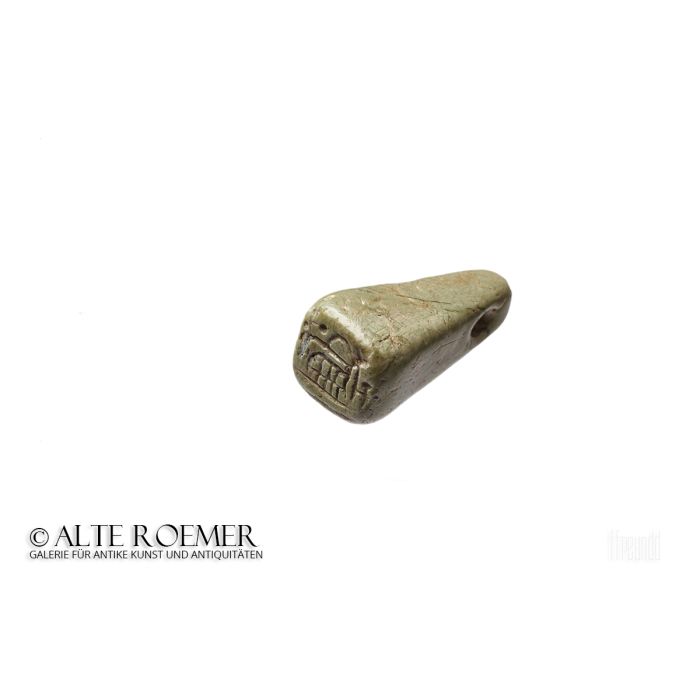Pyramidal stamp seal
Price: on request
Sold
Object number
AR1954-01
| Object: |
Iron Age pyramidal stamp seal
|
| Material: |
Light green stone.
|
| Period: |
Early Iron Age, 1200 BC to 1000 BC. |
| Description: |
Stamp seal in the form of a tall pyramid with a rounded tip. A through hole in the tip made it possible to thread the seal. The square stamp area is engraved with the following motif. The centre is filled with an abstractly depicted large stag. Between its legs is a grid-like framework, either a schematically engraved twig or a centipede. A man is standing in front of the stag and is either threatening it with a spear or trying to tame it with a rope. There are at least two circles above the stag's abdomen, which are probably to be interpreted as astral signs. The iconographic details are reminiscent of early Iron Age stamp seals from the Amuq region in northern Syria (see references). It is possible that this seal also has its origin there. Alternatively, an origin from the region of south-eastern Anatolia is conceivable. |
| Dimensions: |
22mm long, stamp area c. 11mm x 11mm. Loop hole c. 1.9mm diameter.
|
| Condition: |
Museum condition. Perfectly preserved apart from minimal chips.
|
| Provenance: |
From the German collection of Professor H. Brosch (1923 to 2009), author of historical publications, scientific museum advisor, decorated by the Order of Merit of the Federal Republic of Germany. The collection was built between 1960 and 1975. It was inherited to U. Buechner, Germany, and then acquired by us in 2013.
The Professor Brosch collection of ancient Gems: After the decline of the Roman Empire, ancient gems retained or regained recognition in medieval Europe. In addition to frequent reuse in church art, there were also profane uses. This is shown by the example of the ancient intaglio of Julia, daughter of Emperor Titus. It was reused in the 9th century by the Merovingians in the "Escrain de Charlemagne" and can be admired today in the French National Library. The reception of ancient glyptic during the Italian Renaissance resulted in a great fashion to collect gems, which could be entertained by the European educated bourgeoisie during journeys through the Mediterranean in the spirit of enlightenment and education. Thus Goethe, inspired by his trip to Italy, which was immortalised in literature, also built up a collection of antiquities. The collection of ancient intaglios by Professor Brosch is certainly a late classicist continuation of this tradition. The collection forms a systematic cross-section of the thematic diversity of ancient gems and has been worked on extensively with a scholarly approach. Professor Brosch had a great interest, not only in ancient history, but also in the more recent history of his home region. He was honoured with the Federal Cross of Merit for his achievements in the field of historical studies. It is with pride that we have fully documented this collection and provided it with literature references. We are now pleased to bring these miniature works of art from the ancient world back into circulation and to enrich a collection in the tradition of the Renaissance and Enlightenment in a worthy manner. If you are interested in purchasing the collection in its entirety, please do not hesitate to contact us. |
| References: |
The iconographic details similar Jan Waalke-Meyer, Die eisenzeitlichen Stempelsiegel aus dem 'Amuq-Gebiet, OBOSA 28 (2008), p. 259, nos. 2, 4 and 5. For the shape, however smaller, cf. form class IA.6, p. 40, fig. 21. For the square stamp area cf. p. 62, fig. 37:3. |
| Authenticity: |
We unconditionally guarantee the authenticity of every artefact, all items are subject to our lifetime return policy on authenticity.
|


